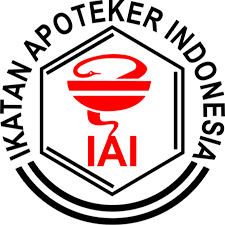EFFECT OF BLACK RICE BRAN EXTRACT (Black Rice Bran) TO DECREASE DECREASE OF GLUCOSE LEVEL IN DIABETIC RATS
Novita Sari(1*), Arifah Sri Wahyuni(2)(1) Universitas Muhammadiyah Surakarta
(2) Universitas Muhammadiyah Surakarta
(*) Corresponding Author
Abstract
Black rice bran is one of processed foods derived from plants and has a decreasing effect of blood glucose
levels. Major component of anthocyanin in black rice bran that functions in lowering blood glucose
concentration is cyanidin 3-glucoside. Fifteen male rats Sprague-Dawley strain were selected randomly and
divided into 5 groups with the same number in each groups. These groups were consisted of normal control,
negative control, and black rice bran extract treatment with dose of 50, 100 and 200 mg/kg of bodyweight
(b.w.). Each of them were induced to experience diabetes by alloxan 150 mg/kg of b.w. Measurement of
blood glucose levels was done by using visible spectrophotometer at 546 nm. The samples were collected
before and after alloxan injection, and after 4, 7, and 10 days later to observe the changes of blood glucose
levels. The results showed that black rice bran at 200 mg/kg of b.w. was able to lower the glucose levels,
which amounted for 131,33 ± 8,08 mg/dL after 10 days of injection.
Full Text:
PDFReferences
Brahmachari, G., 2011, Bio-flavonoids with promising anti- diabetic potentials : A critical
survey, Anti-diabetic bio-flavonoids, 661 (2), 187–212.
Campbell, Reece, & Mitchell, 2004, Biologi. Edisi Kelima Jilid 3, Alih Bahasa: Wasmen
Manalu, Editor: Amalia Safitri, Jakarta, Erlangga.
Dwinani, N., S., 2010, Kemampuan Estrak Etanol Bekatul Beras Hitam Dalam Menurunkan
Kadar Glukosa Darah Pada Tikus Nefropati Diabetes, Skripsi, Fakultas Farmasi,
Universitas Muhammadiyah Surakarta.
Etuk & Muhammed, 2010, Evidence Based Analysis of Chemical Method of Induction of
Diabetes Mellitus in Experimental Animals, Society of Applied Sciences, 1 (2), 331–336.
Hadi, A., 2015, Aktivitas Antioksidan Etanol Ekstrak Bekatul Beras Hitam (Oryzae sativa L.
indica) dan Bekatul Beras Merah (Oryza nivara) Beserta Penetapan Total Antosianin,
Skripsi, Fakultas Farmasi, Universitas Muhammadiyah Surakarta.
Haznam, M.W., 1991, Endokrinologi, 37, Percetakan Angkasa Offset.
Hu, C. et al., 2003, Black Rice (Oryza sativa L. indica) Pigmented Fraction Suppresses both
Reactive Oxygen Species and Nitric Oxide in Chemical and Biological Model Systems,
Journal of Agricultural and Food Chemistry, 51, 5271–5277.
Kaneda, I., Kubo, F. & Sakurai, H., 2006, Antioxidative Compounds in the Extracts of Black
Rice Brans, Journal of Health Science, 52 (5), 495–511.
Malviya, N., Jain, S., & Malviya, S., 2010, Review Antidiabetic Potential of Medicinal Plants,
Acta Poloniae Pharmaceutica-Drug Research, 67 (2), 113-118.
Modak, M., Dixit, P., Londhe, J., Ghaskadbi, S., & Devasagayam., 2007, Indian Herbs and
Herbal Drugs Used for The Treatment of Diabetes. J. Clin. Biochem. Nutr, 40, 163–173.
Nontasan, Moongngarma, & Deeseenthumb, 2012, Application of Functional Colorant Prepared
from Black Rice Bran in Yogurt, Journal Article, Procedia 2 (2012) 62–67.
Park et al., 2008, Isolation of Anthocyanin from Black Rice (Heugjinjubyeo) and Screening of
its Antioxidant Activities, Korea Journal Microbial Biotecnology, 36 (1), 55–60.
Sasaki, R. et al., 2007, Cyanidin 3-glucoside ameliorates hyperglycemia and insulin sensitivity
due to down regulation of retinol binding protein 4 expression in diabetic mice, Biochemical
Pharmacology, 74, 1619–1627.
Suliartini, N. W. S., Sadimantara, G. R., Wijayanto, T., & Muhidin., 2011, 43 pengujian kadar
antosianin padi gogo beras merah hasil koleksi plasma nutfah sulawesi tenggara, Crop
Argo, 4 (2), 43–48.
Suryaningrum, A., 2015, Penetapan Kadar Sianidin-3-O-Glukosida Dalam Ekstrak Etanol 96%
Bekatul Beras Hitam (Oryza Sativa L. Indica) Dan Bekatul Beras Merah (Oryza Nivara)
Menggunakan HPLC-PDA, Skripsi, Fakultas Farmasi, Universitas Muhammadiyah
Surakarta.
Suyono, S. 1995, Kecenderungan Peningkatan Jumlah Pasien Diabetes. In : Soegondo, S.,
Soewondo, P., Subekti, I. (eds.) Diabetes Melitus Penatalaksanaan Terpadu, 5-6, Jakarta,
FKUI.
Suzana, L., 1992, Mempelajari Substitusi Parsial Dedak Padi (Bekatul) terhadap Tepung Terigu
(Triticum vulgare), sebagai Sumber Dietary Fiber dan Niasin, dalam Pembuatan Roti
Manis dan Biskuit, Skripsi, Fakultas Pertanian, Universitan Institut Pertanian Bogor.
Szkudelski, T., 2001, The Mechanism of Alloxan and Streptozotocin Action in B Cells of The
Rat Pancreas, Physiological Research, 50: 536-546.
Tapas, A. R., Sakarkar, D. M. & Kakde, R. B., 2008, Flavonoids as Nutraceuticals: A Review,
Tropical Journal of Pharmaceutical Research, 7 (3): 1089-1099.
Tjokoprawiro, A., 1999, Diabetes Mellitus: Klasifikasi, Diagnosis dan Terapi, 8, Jakarta,
Gramedia Pustaka Utama.
Utaminingsih, E., 2015, Pengaruh Pemberian Ekstrak Bekatul Beras Hitam (Black Rice Bran)
Terhadap Kadar Insulin Darah Pada Tikus Hiperglikemik, Skripsi, Fakultas Farmasi,
Universitas Muhammadiyah Surakarta.
Wild, S. et al., 2004, Global Prevalence of Diabetes Estimates for the year 2000 and projections
for 2030, Diabetes Care, 27 (5), 1047–1053.
Article Metrics
Abstract view(s): 1069 time(s)PDF: 1709 time(s)
Refbacks
- There are currently no refbacks.









